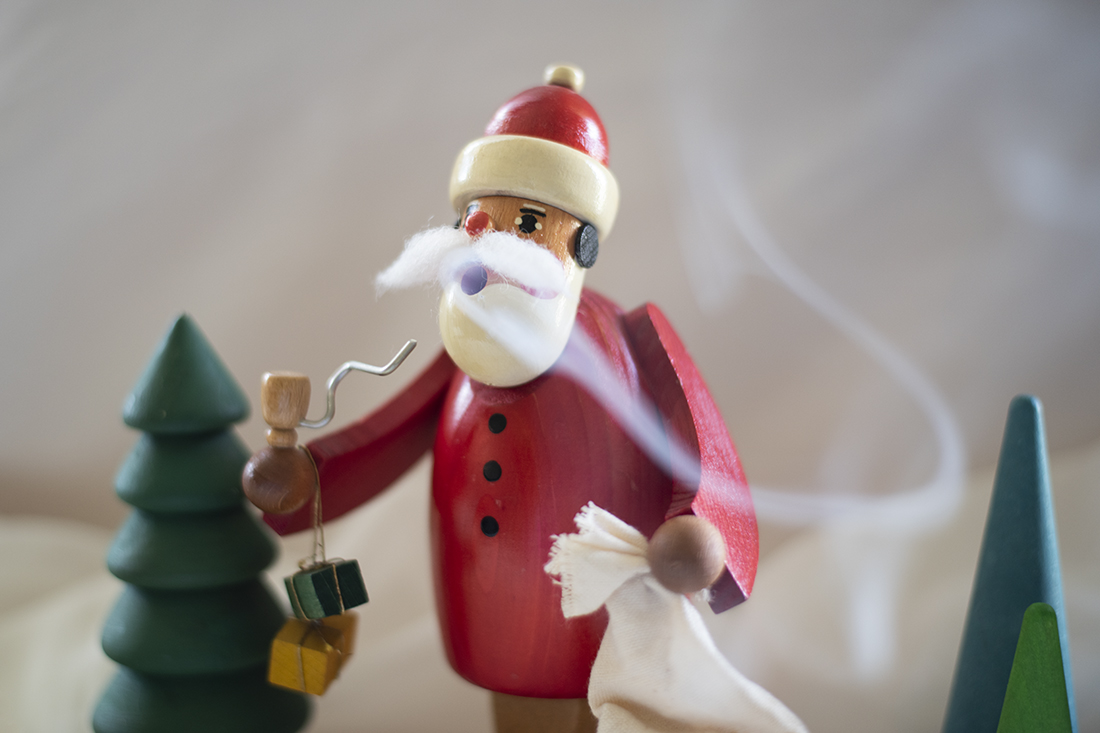One of my favorite Advent and Christmas time traditions is burning incense in my small collection of German smokers, known as Räuchermännchen or Räuchermen. These incense smokers are made of wood and typically have two parts: A flat base where the incense cone is placed; and a second, hollow piece that that acts as a lid. Whether it’s a human figure, an animal, or a small building, all of the incense smokers have a small hole in the lid that lets the smoke from the incense escape. Räuchermen often depict people engaged in different occupations—popular figures include bakers, woodsmen, shepherds, and miners, as well as fairy tale and holiday characters. You might also find smokers in the shape of bees, owls, snowmen, and mushrooms. It’s delightful to see a wooden Santa Claus figure with a pipe and real smoke coming from under his whiskers. I also have a small house incense burner that depicts a winter scene, and the smoke comes right out the chimney!
History of Räuchermen
Räuchermen, in their present form, have been made in the Erzgebirge (“Ore Mountain”) region of Germany since about 1830. This area of Germany was once rich in silver and tin deposits which were continuously mined for over 800 years before the ore was seriously depleted. To survive, the newly unemployed miners took up woodcarving and toy-making, using the plentiful lumber available in the region. Various innovations in lathe-turning made assembly-line production possible, and whole families could find work carving, painting, and assembling home decorations and toys. Many of the Erzgebirge creations celebrate village lore, stories of the Christian faith, and the mining history of the region.1
“Smoke Nights” in Germany
The tradition in Germany of burning incense in Räuchermen may date back to the pre-Christian era when it was believed that evil spirits roamed about the countryside during the longest nights of the year, the so-called “rough nights” or “smoke nights” (Raunaeachte) that occur around the time of the Winter Solstice. Pagan communities would burn incense to bless their homes and drive the spirits out. When Germany was Christianized, this custom evolved to incorporate the Three Wise Men of the Nativity story. On the Feast of the Epiphany (January 6th), men from the community would dress as the Three Kings and go from home to home with incense burning in censers to offer a blessing. They would mark their initials—C[aspar] + M[elchior] + B[althasar]—in chalk on the lintel of the door to show the home had been cleansed and blessed. The Church still encourages this tradition today, with the blessing of chalk at Mass to be used by parishioners in their homes at Epiphany.2,3
Start Your Own Collection
There are many types of incense available to use in Räuchermen, but some of the most common are those scents that capture the essence of the Christmas season like fir tree and frankincense. Other scents like honey, lavender, lemon, orange, and violet are also popular.4 Many people enjoy collecting new and vintage Räuchermen. You can buy new incense smokers from various online German handcraft vendors like Erzgebirge Palace or Christkindl Markt. There are also a wide variety of Räuchermen for sale on eBay and Etsy. Whether you own one or many, burning incense in your whimsical German smoker is sure to become a beloved holiday tradition year after year.
Here’s a neat video showing how traditional Räuchermen are made:
ENDNOTES
1Charleen Smith-Riedel, “The German toymakers of the Erzgebirge,” Folklife, January 6, 2021, https://folklife.si.edu/
2 Tom A. Jerman, Santa Claus Worldwide (Jefferson, NC : McFarland & Company, Inc., 2020), 45
3“The history of Steinbach smokers,” www.Christmas-Treasures.com
4“German smokers,” German Handcraft, www.German-Handcraft.com



